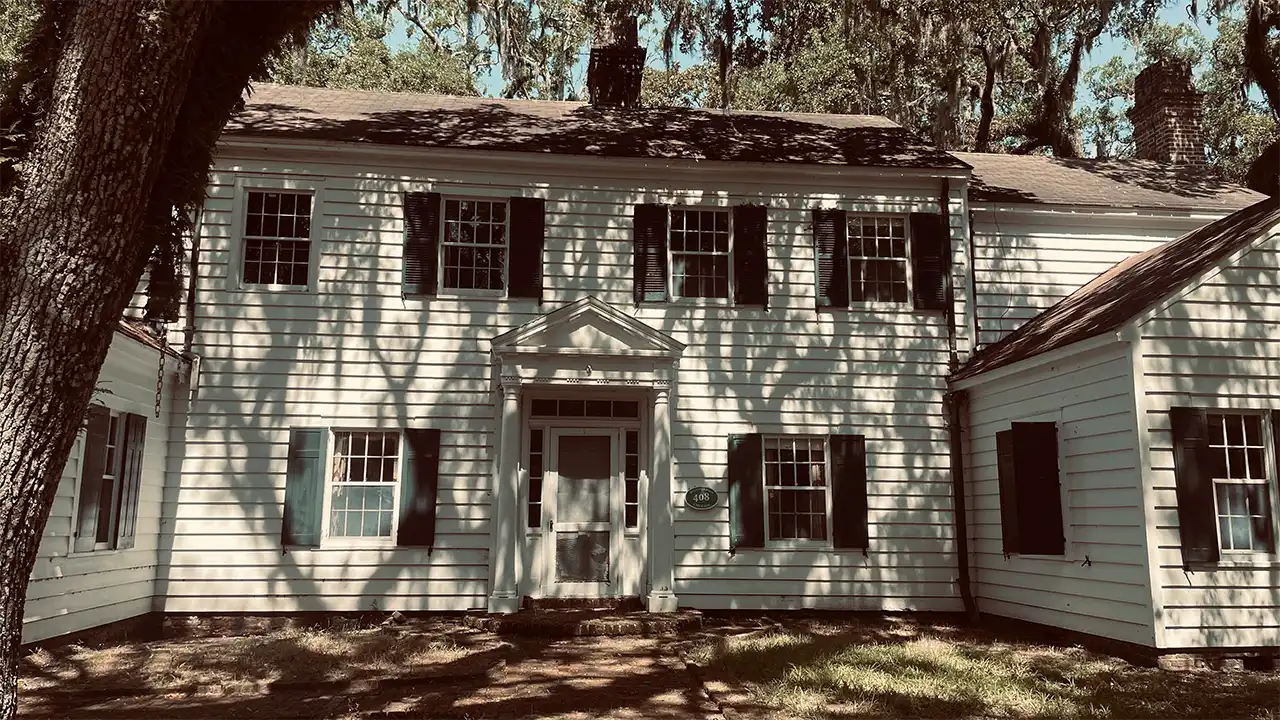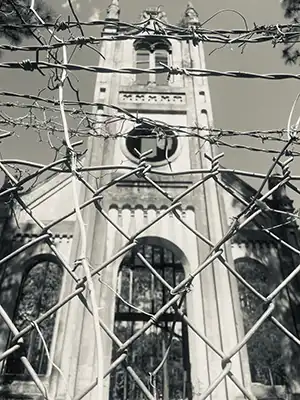
Against this backdrop of our region’s checkered history, it is impossible to ignore that coastal South Carolina is a portal for hauntings. It all began with the arrival of early settlers and wealthy planters in the Lowcountry, the indigenous population was eliminated due to slavery and disease. Then Africans came ashore in droves, forced to work the land, often in dangerous conditions. During the Revolutionary War, British Redcoats occupied much of this region, sometimes pillaging and burning entire villages in their wake. During the Civil War, Confederates battled against Union soldiers, ruthlessly killing one another in the name of states’ rights and slavery. Over the last century, wealthy Northerners descended here, purchasing dilapidated plantation homes and renovating them into elegant hunting lodges in which to entertain illustrious friends.
 Our neighboring Georgetown, which 30-45 years ago, was so rampant with tales of haints, hags and plat-eyes that it became renowned as the “Ghost Capital of the South.” Let these legends speak for themselves and then make your own inferences. These might make you do a double take next time.
Our neighboring Georgetown, which 30-45 years ago, was so rampant with tales of haints, hags and plat-eyes that it became renowned as the “Ghost Capital of the South.” Let these legends speak for themselves and then make your own inferences. These might make you do a double take next time.
Take for example the trendy “haint blue” we see painted on countless porch ceilings around the Lowcountry. This timeless tradition, according to local historian Paige Sawyer, dates back to the plantation era when the enslaved applied patches of indigo around the door of their cabins in the belief that the color would confuse and thus prevent evil spirits from entering their dwellings by way of the air or waterways reflecting the blue sky.
Then there’s the Prince Frederick Church, a Gothic Revival style structure constructed between 1859-1876 and located off a now obscure road in Plantersville several miles outside of Georgetown. After the Civil War ended, tithes dried up and emancipation left no one to work the land or maintain the grounds. Consequently, the abandoned building fell into disrepair. Now only the facade of the church remains, casting eerie shadows through the silent forest and across the adjacent graveyard. Prison-like security fences ensconce the property, preventing tire kickers from sneaking onto the property to desecrate tombstones and steal bricks from the ruins to take home as souvenirs.
BLOOD BROTHERS
The site, also known as Old Gunn Church, named after its two architects and builders, brothers Philip and Edward Gunn, is, according to acclaimed author and tour guide at Hopsewee Plantation Elizabeth Huntsinger, “The site of very strange and eerie occurrences.” In her book “Haunted Georgetown,” Huntsinger said, “Many believe that one of the Gunn brothers (it is not clear which), who tumbled to his death while building the church, still haunts the grounds and Georgetonians have told of seeing lights moving in the totally inaccessible upper portion of the tower during the night. Others have heard the bloodcurdling, horrible scream of Gunn as he relives his fatal fall” (See Huntsinger’s “Haunted Georgetown,” Page 77).
UNREQUITED LOVE
Huntsinger, who also served as a ranger at Hampton Plantation, said when she first visited the mansion, she toured the upstairs bedrooms and as she entered one of them, the energy was so heavy and dark she felt like she was intruding on someone’s final private moments in a hospital room, and she abruptly left. While researching the history of the house and its occupants, Huntsinger learned that because of an unrequited love due to a forbidden marriage, John Rutledge, the son of one of the planters, had taken his own life in that very bedroom.
LEAVE THE LIGHT ON
Additionally, Jim Clark, botanist at Mansfield Plantation, said he experienced several bizarre encounters during his time managing Chicora Wood, once the largest rice plantation in Georgetown County and located just up the road from Old Gunn Church. Clark noted that one night he was certain he had turned off the lights, locked up and alarmed the big house and returned to his cottage a football field’s length across the property. Looking back across the swath of land, he noticed lights were still on in the manor. Confused as to what was happening, Clark schlepped back over, flipped the switches and double-checked that he had secured the locks.
Assured, Clark headed home only to realize the lights in the mansion were still on. Thinking there must have been an electrical issue, Clark trekked back over again with a flashlight in hand and investigated the control panel. But nothing was amiss. Leaving the house in darkness, Clark said by the time he reached his home, the lights had come back on. With a twinkle in his eye, Clark added that he decided to leave the mischievous spirit(s) to entertain themselves for the rest of that evening.
SLEEP SHIFTING
Meanwhile, nothing screams ‘haunted’ like being flipped upside down in your bed in the middle of the night. This happened multiple times to director of education at Hobcaw Barony, Richard Camlin, when many years ago he was staying at Bellefield House (constructed in 1936-1937) as a guest of Ella Severin, who received life tenancy for the home from her partner Belle Baruch. Camlin said the first night he slept at Bellefield, he woke up to find he had turned a full 90 degrees in the bed and was shocked the next two mornings when again he awakened to find himself sideways.
FLICKER IN THE DARK
On another occasion when Camlin was staying at the home, he heard a colleague who was washing dishes in the kitchen scream. When he ran to find out what was wrong, she said she had seen a ghost glide out of the adjacent hallway into the office. Although Camlin’s friend was not aware of the spirit’s backstory, she described the phantom as a young man wearing a long coat and carrying a lantern.
Camlin said the effigy is that of Thomas Young, a planter who 200 years ago built Youngfield on the same plot of land as Bellefield stands today. Legend has it, according to Mary E. Miller, author of “Baroness of Hobcaw,” that after finishing work on the plantation every evening, Young’s custom was to visit the site and inspect the building’s progress. Miller added that Young’s “slaves would see his lantern moving from room to room and floor to floor, as he wandered about checking the finished work. When he died from sudden illness, his wife and child moved away and no family ever occupied the house.” Miller said after that, “Travelers on the Waccamaw River swore they saw mysterious lights in the deserted house” (See Miller, “Baroness of Hobcaw,” page 82).
Strange occurrences at Bellefield are not abnormal, according to Camlin, who explained that he has also heard footsteps and voices calling out in the night when no one else was in the house. Additionally, there is a bedroom door that locks and unlocks itself.
When Severin passed away in 2003, Camlin attended her funeral at the chapel in the onsite enslaved Friendfield Village and then stayed the night at Bellefield. When Camlin woke up the next morning, he was positioned as normal, not at the 90-degree angle. Camlin said since the bizarre occurrences stopped after Severin’s death, it seemed as though her spirit had told the ghost that Camlin was good and that it could leave him alone now.
Soon after Severin’s passing, according to Camlin, because of heavy levels of asbestos and lead paint in the house, the mansion was sealed and tours for the public ceased. Now, whether believer or skeptic, when visiting the grounds surrounding the empty 4,000-square-foot manor, it is impossible to disregard the moody presence seeping from behind its walls.
THE GRAY MAN
One of the most prominent legends in the Georgetown and Pawleys Island area is the story of the Gray Man. As the most commonly told tale based in 1822 goes, a nameless rider was on his way back to see his fianceé when a storm suddenly hit. As the man and his horse struggled to cross the marsh, they either drowned or the slippery pluff mud pulled them under. When another upcoming storm ensued, a gray silhouette of the man reappeared on the island as if to warn his fianceé of its danger. The woman and her family left abruptly and upon their return home, they found theirs was one of the only houses standing. Today, according to lore, whenever there is a sighting of the Gray Man, his apparition is an indication that a storm is on its way — and while it is prudent to take precautions, rest assured this good omen means your property will suffer little to no damage.
These stories are just a handful of examples of Lowcountry hauntings that lurk behind the gates of the plantations and walls of historic homes, theaters and churches and throughout hidden backroads, forests, marshes and swamps. While exploring these settings, pay attention to signs such as taps, knocks, bangs, bells, thuds, scraping at the window, random voices, a door randomly slamming shut or a creak in a floorboard. Additionally, orbs often appear in photographs or a sudden headache can seemingly arise from out of nowhere. Because here, in East Cooper, you never know when you might experience your own mysterious and unexplained encounter.
By Sarah Rose & Sophie Rose

Leave a Reply